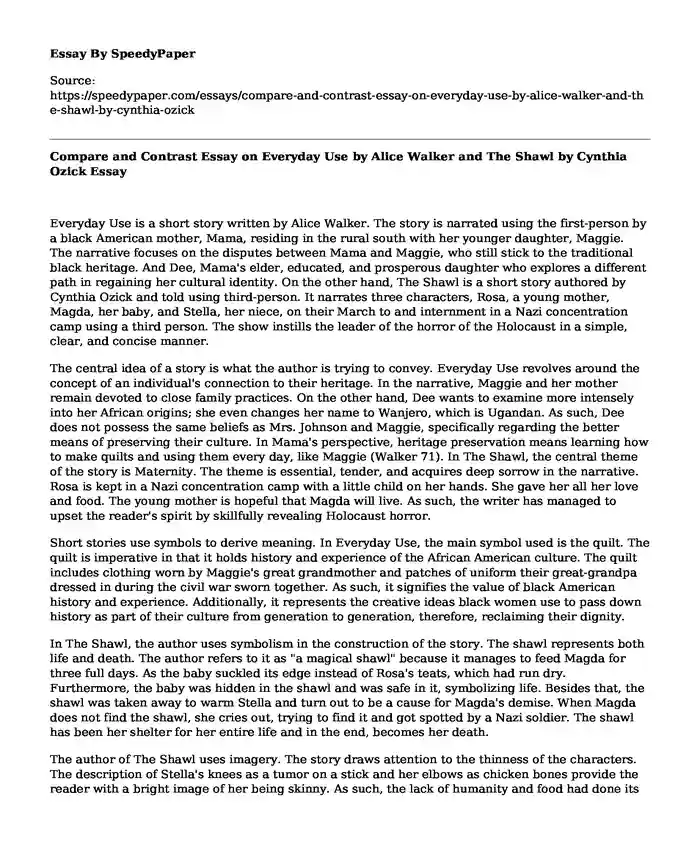
| Essay type: | Compare and contrast |
| Categories: | Alice Walker American literature |
| Pages: | 4 |
| Wordcount: | 829 words |
Everyday Use is a short story written by Alice Walker. The story is narrated using the first-person by a black American mother, Mama, residing in the rural south with her younger daughter, Maggie. The narrative focuses on the disputes between Mama and Maggie, who still stick to the traditional black heritage. And Dee, Mama's elder, educated, and prosperous daughter who explores a different path in regaining her cultural identity. On the other hand, The Shawl is a short story authored by Cynthia Ozick and told using third-person. It narrates three characters, Rosa, a young mother, Magda, her baby, and Stella, her niece, on their March to and internment in a Nazi concentration camp using a third person. The show instills the leader of the horror of the Holocaust in a simple, clear, and concise manner.
The central idea of a story is what the author is trying to convey. Everyday Use revolves around the concept of an individual's connection to their heritage. In the narrative, Maggie and her mother remain devoted to close family practices. On the other hand, Dee wants to examine more intensely into her African origins; she even changes her name to Wanjero, which is Ugandan. As such, Dee does not possess the same beliefs as Mrs. Johnson and Maggie, specifically regarding the better means of preserving their culture. In Mama's perspective, heritage preservation means learning how to make quilts and using them every day, like Maggie (Walker 71). In The Shawl, the central theme of the story is Maternity. The theme is essential, tender, and acquires deep sorrow in the narrative. Rosa is kept in a Nazi concentration camp with a little child on her hands. She gave her all her love and food. The young mother is hopeful that Magda will live. As such, the writer has managed to upset the reader's spirit by skillfully revealing Holocaust horror.
Short stories use symbols to derive meaning. In Everyday Use, the main symbol used is the quilt. The quilt is imperative in that it holds history and experience of the African American culture. The quilt includes clothing worn by Maggie's great grandmother and patches of uniform their great-grandpa dressed in during the civil war sworn together. As such, it signifies the value of black American history and experience. Additionally, it represents the creative ideas black women use to pass down history as part of their culture from generation to generation, therefore, reclaiming their dignity.
In The Shawl, the author uses symbolism in the construction of the story. The shawl represents both life and death. The author refers to it as "a magical shawl" because it manages to feed Magda for three full days. As the baby suckled its edge instead of Rosa's teats, which had run dry. Furthermore, the baby was hidden in the shawl and was safe in it, symbolizing life. Besides that, the shawl was taken away to warm Stella and turn out to be a cause for Magda's demise. When Magda does not find the shawl, she cries out, trying to find it and got spotted by a Nazi soldier. The shawl has been her shelter for her entire life and in the end, becomes her death.
The author of The Shawl uses imagery. The story draws attention to the thinness of the characters. The description of Stella's knees as a tumor on a stick and her elbows as chicken bones provide the reader with a bright image of her being skinny. As such, the lack of humanity and food had done its job. Moreover, Magda, who was 15 months old, would not stand as her legs would not hold her body. This appearance is enough for the reader to understand the wretchedness of their state. The depiction of the camps where Jews lived provides an image of its wretchedness. Filth, stinking, and floating smoke in a place where people eat, reside, and sleep.
In Everyday Use, the yard is seen as an expanded habitable room (Walker 71). Mrs. Johnson and Maggie clean the yard preparing for Dee's visit. Besides, they sit in the yard for hours since Dee's left. As such, it appears to be a convenient place for Mama to reflect, where she can envision herself more traditionally attractive. And recall how much she has done for the family. Moreover, Mrs. Johnson's man-working hands indicate a tough life with high exposure to work (Walter 72). As such, the reader can create vivid images of Mama and her hands that can kill a hog. Maggie's marks on her body also help the leader to form pictures of her with cars and understand her ruthless journey of life.
In conclusion, the paper has compared and contracted Everyday Use and The Shawl. They are explicitly showing how short stories differ in themes and narrative techniques. Additionally, it has explored the use of symbolism and imagery in the short stories.
Works cited
Ozick, Cynthia. The shawl. Hachette UK, 2012.
Walker, Alice. Everyday use. Recording for the Blind & Dyslexic, 2004.
Cite this page
Compare and Contrast Essay on Everyday Use by Alice Walker and The Shawl by Cynthia Ozick. (2023, Mar 16). Retrieved from https://speedypaper.com/essays/compare-and-contrast-essay-on-everyday-use-by-alice-walker-and-the-shawl-by-cynthia-ozick
Request Removal
If you are the original author of this essay and no longer wish to have it published on the SpeedyPaper website, please click below to request its removal:
- Clinical Trials Going Global - Essay Example
- HRM Essay Sample: The Moderating Role of Organizational Commitment
- American Dream, An Illusion for Latinos, Free Essay on Civil Rights
- Deprecation, Cost Recovery, Amortization, and Depletion - Chapter Summary Essay Sample
- Free Essay on the Impact of 3D Printing on Global Logistics and Technology
- 3.5 Data analysis
- Essay Example on The Fall of the House of Usher by Edgar Allan Poe
Popular categories




